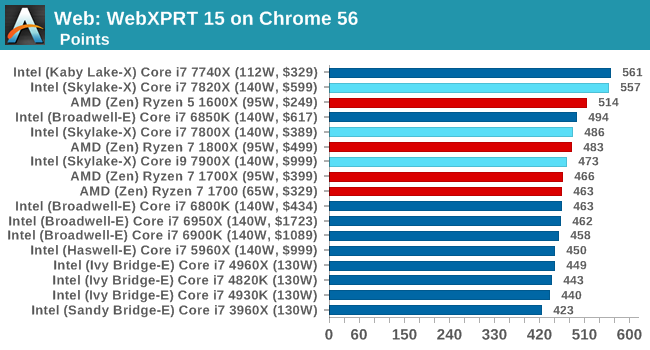The Intel Skylake-X Review: Core i9 7900X, i7 7820X and i7 7800X Tested
by Ian Cutress on June 19, 2017 9:01 AM ESTBenchmarking Performance: CPU Web Tests
One of the issues when running web-based tests is the nature of modern browsers to automatically install updates. This means any sustained period of benchmarking will invariably fall foul of the 'it's updated beyond the state of comparison' rule, especially when browsers will update if you give them half a second to think about it. Despite this, we were able to find a series of commands to create an un-updatable version of Chrome 56 for our 2017 test suite. While this means we might not be on the bleeding edge of the latest browser, it makes the scores between CPUs comparable.
SunSpider 1.0.2
The oldest web-based benchmark in this portion of our test is SunSpider. This is a very basic javascript algorithm tool, and ends up being more a measure of IPC and latency than anything else, with most high-performance CPUs scoring around about the same. The basic test is looped 10 times and the average taken. We run the basic test 4 times.

Sunspider goes after peak frequency most of the time, althoguh there is some variation as it moves into basically becoming a legacy test.
Mozilla Kraken 1.1
Kraken is another Javascript based benchmark, using the same test harness as SunSpider, but focusing on more stringent real-world use cases and libraries, such as audio processing and image filters. Again, the basic test is looped ten times, and we run the basic test four times.

Kraken is more of an intense attack on JS, and still regularly sorts by IPC and frequency.
Google Octane 2.0
Along with Mozilla, as Google is a major browser developer, having peak JS performance is typically a critical asset when comparing against the other OS developers. In the same way that SunSpider is a very early JS benchmark, and Kraken is a bit newer, Octane aims to be more relevant to real workloads, especially in power constrained devices such as smartphones and tablets.

Octane seems to be an optimization target, and with the new Skylake-X it shows.
WebXPRT 2015
While the previous three benchmarks do calculations in the background and represent a score, WebXPRT is designed to be a better interpretation of visual workloads that a professional user might have, such as browser based applications, graphing, image editing, sort/analysis, scientific analysis and financial tools.











264 Comments
View All Comments
FreckledTrout - Monday, June 19, 2017 - link
Missing the 7820x on the power draw graph.Ian Cutress - Tuesday, June 20, 2017 - link
The 7820X power numbers didn't look right when we tested it. I'm now on the road for two weeks, so we'll update the numbers when I get back.chrysrobyn - Monday, June 19, 2017 - link
In my head I'm still doing the math on every benchmark and dividing by watts and seeing Zen looking very different.Old_Fogie_Late_Bloomer - Monday, June 19, 2017 - link
I'm sure I'm wrong about this, but it makes more sense to me that the i9-7900X would be a (significantly) cut down HCC die instead of a perfect LCC. i9 vs i7, 44 vs 28 lanes, two AVX units instead of one?And yet the one source I've found so far says it's the smaller die. It's definitely the LCC die, then?
Ian Cutress - Tuesday, June 20, 2017 - link
HCC isn't ready, basically. LCC is. Plus, having a 10C LCC die and not posting a top SKU would be wasteful of the smallest die of the set.Also, delidding a 10C SKU.
Old_Fogie_Late_Bloomer - Tuesday, June 20, 2017 - link
Well, it wouldn't be a waste if Intel's yields weren't good enough to get fully functional dies. The fact that Intel is not just releasing fully functional LCC chips but announced that they would be the first ones available suggests that they have no trouble reliably producing them, which is pretty impressive (though they have had plenty of practice on this process by now).Thanks for the response; I thoroughly enjoyed the review and look forward to further coverage. Exciting times!
Despoiler - Monday, June 19, 2017 - link
Considering Ryzen is in the desktop category and these Intel chips are HEDT, we need to wait to see what Threadripper brings. AMD won't have the clock advantage, but for multithreaded workloads I suspect they will have more cores at a cheaper price than Intel.FreckledTrout - Monday, June 19, 2017 - link
I wouldn't say AMD wont have a clock advantage once you get to the 14 and 16 core chips. They might not but you saw the power numbers and thermals, Intel very well may have to pull back the frequency as they scale up the cores more than AMD will.FMinus - Thursday, June 22, 2017 - link
Actually I think it's the other way around. AMD might have clock advantage on higher core models thanks to not going with the monolithic approach. Easier to to cool those beasts but power is still an issue.If you imagine four 1800x on one interposer, you can see them reaching 4GHz on all of those dies, that said the power consumption would be massive, but easier cooler as the intel 16 core variant.
Lolimaster - Tuesday, June 20, 2017 - link
The 1995X will have a stock 3.6Ghz for the 16cores, same as the 7900X with just 10.